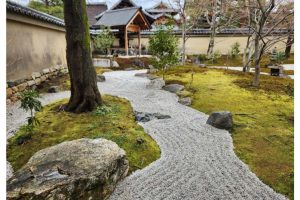
The ultimate guide to weeds: What to yank, what to leave and what you should never ever touch
A plant expert answers questions about every gardener’s nemesis
Portia Corman · CBC Life · Posted: Aug 16, 2019 6:36 PM ET | Last Updated: August 16
I’m lucky. I get to spend most mornings strolling through my garden, coffee in hand, admiring my plants and pulling weeds that dare to raise their unwelcome heads. I find that weeding regularly makes gardening less of a chore and it’s an effective way to stretch a little before breakfast as well.
But no matter how many weeds they’ve plucked, even veteren gardeners get stumped at times trying to determine what is, and what is not, a weed — particularly in the spring when everything is just beginning to peek out of the soil and your winter brain has wiped all your geographical gardening memories clean. “Is this where I planted a patch of Primrose or are these weeds that need to be annihilated?”
When you’re unsure, you can text an image of the suspect to a friend and ask for their opinion (which my friends often do), or, you can use these tips from Jon Peter, the curator and manager of plant records at the Royal Botanical Gardens in Hamilton, Ontario. Then you can make the call to yank it or leave it all by yourself.
What makes a weed, a weed?
Jon Peter: All weeds are plants — they’re just plants in the wrong location. Weeds are generally classified by their life cycle. Annual weeds are plants that grow from seeds that are dispersed by a parent plant each spring. Biennial weeds are plants that grow marginally in the first year, then flower, produce fruit, then die in the second year, and perennial weeds, such as dandelions, lay dormant in winter and return in spring. Weeds are often classified into general categories including lawn weeds, garden weeds, noxious weeds and invasive weeds, as well as their undesirable qualities, including aggressiveness, low aesthetic value, toxicity, etc.
Are they definitively different from plants we buy at garden centres?
JP: No, all weeds come from the kingdom of plants and all weeds will produce flowers (or equivalent reproductive organs). They’re definitely the underappreciated relatives of some of our most beloved garden plants. For example, what may be considered a weed in British Columbia might be considered a garden gem in Ontario. On a larger scale, a beautiful culinary herb that is desirable in Europe and brought to North America for its desirable characteristics can become a menace — even invasive. Such was the case with Garlic Mustard (Alliaria petiolata) which is now a common unwelcome resident in many Ontario gardens.

What makes weeds so prolific?
JP: There are some commonalities which weeds possess in order to gain advantage over desirable ornamental plants. First, they reproduce in a variety of ways. They can spread sexually by seed as well as asexually via rhizomes — a stem that runs underground and shoots out roots like tentacles. Second, some weeds outcompete other species by leafing out earlier and blocking the sun to slower growers. Also, they often hold green leaves later in the fall as well, giving them more time for photosynthesis which ultimately provides them more time and energy to grow, create more seeds and reproduce. By thriving in a multitude of conditions, rapidly establishing and spreading, and by populating areas during droughts, floods and other extreme conditions, weeds have cornered the market on survival.
How do weeds move around?
JP: Weeds can move around in a variety of ways — sexually and asexually, as discussed above, but they can also travel by wind, water, birds, insects, animals and even by hitching a ride on garden tools, power equipment, the mud on your boots or the tires on your truck. When a weed spreads asexually like this, it only requires one parent and the offspring is genetically identical to that parent.
Do weeds serve a purpose? What can they tell me about my garden?
JP: Weeds can tell you a lot about your soil because all plant species prefer specific environmental conditions in order to thrive. Does the soil have too little nitrogen or is it eroded or too compacted? Spotting weeds that signal these issues can help you make helpful changes such as tilling and/or adding organic matter. Some ‘weeds’ such as Goldenrod (Solidago species) and Joe Pye Weed (Eutrochium purpureum) are native species which support Canada’s pollinating insects and birds and contribute to the ecosystem. Milkweed (Asclepias species), for example, provides a nursery for the offspring of Monarch butterflies. Also, Queen Anne’s Lace (Daucus carota) is also considered a weed but can be beneficial in that it attracts predatory wasps, flies and lady beetles which prey on garden pests such as aphids.

Do weeds harm the garden?
JP: Weeds can be detrimental in the garden in a number of ways. Some are aggressive and choke out expensive garden plants. Some are allelopathic which means they produce biochemical(s) that influence the germination of seeds and hamper the growth, survival and reproduction of other plant species, which gives them the advantage over more desirable plants. Others, such as Giant Hogweed (Heracleum mantegazzianum), an invasive species which can grow over 12 feet tall, are extremely dangerous in that they cause burns, blisters and even scarring on the skin when touched. And some, such as Water hemlock, Cicuta species are toxic and deadly when ingested.

What are the most common weeds a Canadian is likely to encounter?
JP: Weeds vary dramatically within small areas so every region of Canada is unique. However, from province to province and within each local ecotype, certain weed species will be more prevalent than others. Many common weeds and invasive species are thankfully more prominent in agriculture (Lamb’s-quarters — Chenopodium album) and in natural areas (Common Reed — Phragmites australis) than they are in our gardens; however, there is some crossover between those areas and our gardens.

Bindweed (Convolvulus arvensis) is a weed which you definitely want to avoid. Although this Eurasian species does feature beautiful morning glory flowers, it’s not welcome in the garden because of its aggressive growth and its ability to resist containment because of its extensive root system. Some reports have said that the roots can grow as deep as 6-30 feet and have seeds which can germinate decades (more than 20 years) later. This vining species twines and climbs up and amongst garden plants and competes for sunlight, moisture and nutrients. If even the smallest piece of root is left remaining in the soil, a new plant will form.

Dandelion (Taraxacum officinale) is most prominent within our over-abundance of turfgrass but are prevalent within our garden beds as well. A plant which needs no description and is one of the most easily recognized plant species in Canada, dandelions can grow in a variety of conditions and are very successful in their reproduction and dissemination via wind dispersed seeds. Their thick taproots can make them virtually impossible to pull and eradicate and dandelions provide early food sources for pollinators in spring, so some Canadians have learned to live with them. Interesting that they were probably brought to North America as a medicinal herb and are again becoming popular as a culinary superfood.

Purslane (Portulaca oleracea) is one of the most common garden weeds and you’ll also find it creeping along the cracks of your driveway and between your interlocking brick work. This ‘annual’ weed whose origins are debated features fleshy, flat reddish-green leaves which creep along the soil on thick prostrate stems and small yellow flowers which open only on bright sunny mornings. The fleshy leaves and stems are basically organs for water and nutrient storage which can give them an advantage in dry soil and drought conditions and help them tolerate compacted soils. The fleshy nature of purslane enables it to continue to flower and produce seeds for several days after being pulled and it is important to get every part of the root removed as it will re-establish quite effectively from even a small portion of root remaining in the soil. Just like dandelion, this species has a long ethnobotanical history and is becoming popular once again in the culinary world.

Canada Thistle (Cirsium arvense) sounds like it’s native to Canada however, it’s actually a descendent from Asia and Europe and should be called ‘Creeping Thistle’ or ‘Field Thistle’ in order not to confuse us. This “noxious weed” reproduces by wind-dispersed seed and by a colonizing root system which allows it to form dense patches or monocultures. Canada Thistle is a ruderal species — a species which is first to colonize disturbed land. The spread by an underground network of roots, along with the spiny leaf edges and stems, make this weed difficult to deal with in any situation. Though it’s a pest in the garden, this species also plays an important role in the ecosystem. Its purple flowers are visited by a wide variety of insects, the seeds are an important food source for birds like goldfinch and its leaves are used as food by many species of butterflies and moths.

Plantain (Plantago major) is a Eurasian-native species which only reproduces via seed and is commonly found in many gardens because it does well in compacted as well as disturbed soils. It was likely one of the first plant species brought to the new world as it is prized for its medicinal and culinary uses. Plantain has anti-inflammatory, analgesic, antioxidant, antibiotic and astringent properties and its leaves are very high in vitamins A, C, K and calcium. Plantain forms a basal rosette of large oval shaped leaves with prominent leaf veins and a taller flower spike containing many small greenish flowers. Although this plant is small in scale (generally reaching 6 inches tall and leaf spread of up to 12 inches) it reproduces on a large scale, with one plant producing up to 20,000 seeds, ensuring its survival and ongoing spread.

Common Milkweed (Asclepias syriaca) is an example of a North American native plant that gained a negative ‘weedy’ reputation. However, with the renewed interest in the health of pollinators (bees and butterflies) and the challenges they face, this species is finally turning around. Milkweed is now recognized as a desirable species to cultivate in the garden because the benefits it provides to the ecosystem far outweigh its aggressive tendencies. This beautiful perennial plant which features large rounded leaves, spherical clusters of pink flowers, and unique seed ‘pods’ will spread and colonize an area via its horizontally spreading underground roots. All parts of the plant contain a thick, white, milky sap which can be toxic to animals but provides benefits to the insects which feed on it — the monarch butterfly perhaps being the most famous. The monarch lays its eggs exclusively on Milkweed leaves and when the larvae hatch, they feed on the leaves until they’re ready to become a chrysalis and, ultimately, a butterfly. Adult monarchs get energy-rich nectar from the flowers of the plant.
Which Canadian weeds are particularly dangerous and/or invasive?
JP: There are a number of weeds which are considered noxious or invasive and they are generally defined as species whose introduction or spread threatens the environment, the economy, or human health. In Ontario alone, there are over 400 species considered to be invasive. In Canada, invasive plants cost an estimated $2.2 billion each year by reducing crop yields and quality and increasing the cost of weed control and harvesting.
Species like Dog-Strangling Vine (Vincetoxicum rossicum and Vincetoxicum nigrum), Garlic mustard (Alliaria petiolata), Buckthorn (Rhamnus cathartica), and Japanese Knotweed (Reynoutria japonica) threaten biodiversity and have adverse effects on the environment. Species like European Water Chestnut (Trapa natans), Water Soldier (Stratiotes aloides) and Common Reed (Phragmites australis) have adverse effects on recreational activities like swimming, boating and fishing and on reproductive strategies of fish, turtles and birds. Species like Giant Hogweed (Heracleum mantegazzianum), Poison hemlock (Conium maculatum) and Poison ivy (Toxicodendron radicans) can be detrimental to human health with exposure causing allergic reactions and dermatitis.










In spring, it can be difficult to determine what is a weed and what is a flower, especially when things are just emerging. Do weeds have certain tell-tale characteristics that make them easier to identify?
JP: In a garden setting, it can be unclear which plants are meant to be there and which are invaders. Mark the locations of your desirable plants so that you know approximately where they will emerge. Anything that emerges in other locations may be a weed. There aren’t specific morphological characteristics within these plants that tell you they are weeds. If you see lots of seedlings emerging in mass or clusters, they could be weeds. If you see plants emerging or greening up earlier than our native species in spring, they could be weeds. Take pictures of the difficult ones and send to your local public garden or a friendly gardener you know — hopefully they will help you identify them.
What should you do if you aren’t sure if it’s a weed or a flower?
JP: First, remember that all weeds are plants too. Best advice is to be patient, sometimes the identity of the plant can’t be guaranteed until the plant is flowering so waiting is often the best thing to do. Proper identification is the most important step in determining what you’ll need to do to either abolish or control a plant. And some plants can be toxic to humans, so it’s important to know what things are before dealing with them. Wear proper protective gear if you are uncertain.
What weed-killing options can you recommend?
JP: There isn’t one solution for dealing with every weed. The most important thing is to properly identify the weed in order to figure out the best method(s) of control and to check which pest control products are legal to use in the province you live in. Knowing the identification of the weed will allow you to learn about the lifecycle and therefore when/how to best use your control methods. Often multiple methods of control will need to be used over a number of years in order to get a handle on the problem.
It really comes down to hard work. Hand pulling is my go-to control method — I like to provide some irrigation or wait until after a good rain to pull weeds while the soil is moist so the pulling is easier. Also, try to find time to pull weeds regularly as the smaller they are, the easier they will be to remove. Timing of pulling some weeds is also critical. You want to ensure you pull them before they set seed so that the problem isn’t persistent. Also, remove all pulled weed debris from the garden and do not incorporate it into your compost bin. Other methods of control can be used at the proper time of year (and some with guidance recommended) including: cultivating and tilling the soil, solarisation (using polyethylene sheets laid on the soil surface to cook the weeds and their seeds); adding nutrients (as many weeds prefer nutrient poor soils); and by planting a plethora of desirable plants. By filling the empty spaces with desirable trees, shrubs, perennials and groundcovers, you will eliminate the soil space and sun exposure available for weeds to germinate and multiply.
Do you think gardeners are too touchy about weeds — should we be more forgiving?
JP: Yes, people are probably too touchy about weeds. Our need for perfection leads to an intolerance of weeds. Some weeds add benefit to our gardens and ecosystems so it’s important to be informed and know what to yank and what may be worth leaving alone. That being said, we do need to be careful to not let things get out of control.
What is your personal favourite weed and why?
JP: In my job at Royal Botanical Gardens, I’m always working with the scientific binomial names of plants and I love the scientific names of a bunch of weeds. Medicago lupilina commonly known as Black Medic for example, is a common weed in lawns and gardens and I just love the way it rolls off the tongue.

What are the best resources for information on weeds?
JP: Since every province is unique, it’s wise to refer to websites with information specific to the province you live in.
Invasive Species Council of British Columbia
Alberta Invasive Species Council
Identification Guide For Alberta Invasive Plants
Saskatchewan Invasive Species Council
Invasive Species Council of Manitoba
Ontario Invasive Plant Council
Newfoundland and Labrador Invasive Species Council
New Brunswick Invasive Species Council
PEI Invasive Species Council
Invasive Species Alliance of Nova Scotia
Non-Native & Invasive Species in Nunavut
Environment and Natural Resources Northwest Territories
Yukon Invasive Species Council
Canadian Council on Invasive Species
Government of Canada
Do you have a good tip for reducing weeds? Tell us about it in the comments below.



